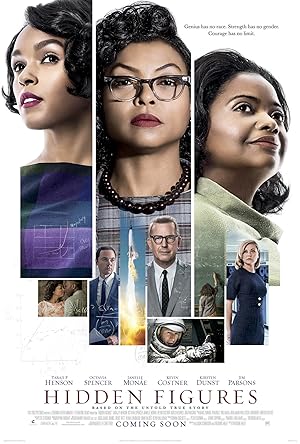Hidden Figures is a deeply conventional movie about a sadly unconventional topic: the lives of black women who did essential work at NASA, but whose legacy was taken for granted and largely unknown by the public until now. Hidden Figures is an adaptation of a book that I plan to read as soon as possible. Hidden Figures stars Taraji P. Henson, Octavia Spencer and Janelle Monae, who has distinguished herself as a talented singer/songwriter and versatile actor.
When I call Hidden Figures a conventional movie, the narrative structure comfortably fits the standard biopic. Hidden Figures gives us a perfectly calculated amount of doses of life at work and home of the notable women, keeps up momentum and provides resolution for all problems before the end of the movie, which is of course, a happy ending.
What makes Hidden Figures a deeply unconventional movie is it is as much a portrait of a concept as a biography about the three black women. Hidden Figures is a movie about intersectionality, and the difficulties that black women face because of racism and sexism from moment to moment. Hidden Figures creates suspense by never allowing the audience to know which obstacle will try to thwart the women from moving ahead and consequently threaten NASA’s success. Hidden Figures correctly asserts that America’s success is completely dependent on whether or not as a nation we care more about dehumanizing a group of people to retain comfortable spaces for the majority, and whether the nation will just have to fail because the fruit from the hate tree provides too many (psychological) benefits to the majority. Hidden Figures provides an optimistic answer, but leaving the theater, the answer seems to be the complete opposite, particularly when it comes to our most vulnerable citizens. There would not be a space race today because we would probably be cool with the USSR beating us while the real snowflakes keep their safe spaces, segregation and derisively call people smarter than them computers as if it is nothing.
Hidden Figures makes audiences question whether or not we even deserve to be in space. Hidden Figures creates a portrait of women who are treated dismissively, forced to work in difficult conditions, and perform better than her colleagues in order to retain, forget excel or get extra credit, at a job. Hidden Figures is a portrait of how black women can’t help it: they want to be excellent, and they will save you while they are at.
Hidden Figures cleverly uses humor and introduces seemingly tertiary details throughout the film that later become crucial plot turning points. Hint: check out the enormous empty room in the beginning of Hidden Figures. It is practically its own character.
Special shout out goes to John Glenn, the real Kevin Costner figure. Between The Right Stuff and Hidden Figures, he seems to be one of the few consistently decent people who could boast about what he would have done if he lived before 1863. Also I would keep my eye on Glen Powell’s career.
Hidden Figures is a must see American film not only because it makes us feel good, but because it is a cautionary tale about how a rising tide lifts all boats.
Stay In The Know
Join my mailing list to get updates about recent reviews, upcoming speaking engagements, and film news.





